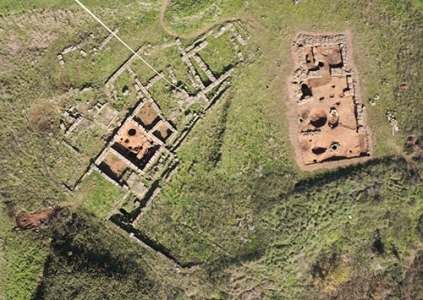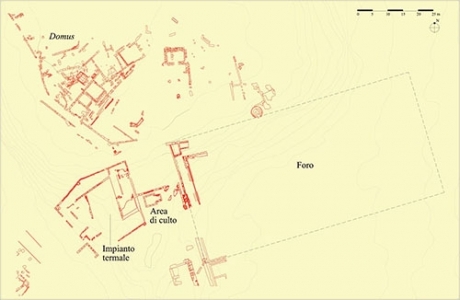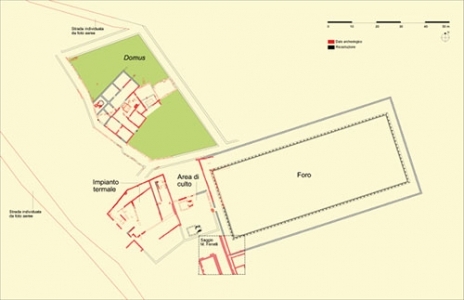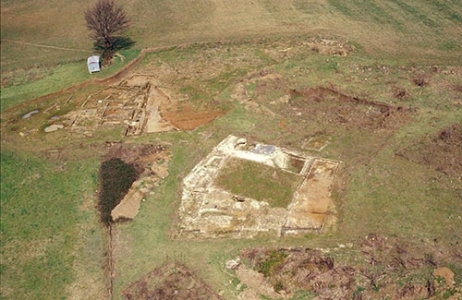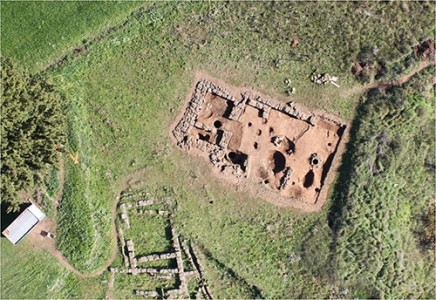Excavations at Veii, Macchiagrande
The research area is on a relief between Macchiagrande and Vignacce, in a central position of the plateau on which the city extends. Here, some anomalies identified interpreting aerial photographs had revealed the existence of submerged structures of great archaeological interest. Especially, a regular anomaly corresponding to a rectangular shape of about 80x40 m which turned out to coincide with the Forum of the Augustan town hall. From these premises, our excavation began. It revealed an uninterrupted occupation from the Villanovan age to the late Antiquity.
The identified periods are as follows:
Period 1: from the Villanovan age to the middle of the sixth century BC. The oldest evidence of occupation in this sector of the built-up area consists of holes for house poles, ditches and canals related to wooden structures that - in at least one case - it was possible to date preliminarily from about half of the 9th century BC
Period 2: in the middle of the sixth century BC, the area is occupied by at least three new structures in opus quadratum of grey tuff, that partly reuse even older walls in red tuff (mid-7th century BC). The new buildings, with a rectangular layout, within divided into two or three rooms, are arranged in an orthogonal manner on the slope. They face south on a road that crosses the high ground in an east-west direction running parallel to the other street - lower - which connects the city' north-western gateway with the Acropolis of Piazza d'Armi. In the central building, you can recognize a small paved courtyard attached to the house. To the east, there is an area with cult features. Here is the so-called building ‘E’, of 100 square meters ca., it has, unique in the area, double-row walls of blocks. The analysis of the stratigraphic sequence and the study of the ceramic finds allowed us to recognize, for this building, 3 periods of life dated between the end of the 7th century BC and the 1st century AD. The landscape outlined in Macchiagrande for the archaic and classical age is preserved for a long time until the end of the 4th / beginning of the 3rd century BC when the ‘E’ building and a well contained in it are obliterated. The other buildings in blocks did not undergo modifications until the middle of the 2nd century BC. This layout seems to confirm what is documented in other areas of the city: the date of 396 BC, the year of the Roman conquest and of the destruction of the enemy city - as the ancient written sources tell us - has not left such enough evidence.
Period 3: In the Republican age, the archaic quarter was abandoned, partly replaced by a large domus with an irregular layout (approx. 330 square meters). The structure is open on a carriageable road that runs along the front of the house. In the centre of a small portico is a ramp that leads, into a vestibule; from there you enter into a larger central room with a tub and well in tuff slabs. The foundations and part of the building’ walls are preserved with remains of parietal (painted plasters) and floor (also decorated cocciopestos) coverings. The rest of the complex seems instead to be occupied by a vast hortus with a cistern.
Period 4. The domus is modified and enlarged several times starting from the first imperial age. In these years, on the SE side of the domus, the Forum of the municipium Augustum Veiens is realized. The excavation found it in a state of considerable dismission which has nevertheless allowed to propose a reconstruction. The central and uncovered part of the square had to be surrounded on all four sides by a columned portico, which we believe to be of Doric order, on which other structures stood, in some cases framed in turn by columns. On the short western side of the Forum, at a slightly higher altitude, there is a small aedicula, in a fenced area in line with the square, inside which there could also be a second aedicula. Behind it, is a large building with an irregular plan - articulated in narrow and elongated spaces arranged around what appears to be an open court. The building, with floor mosaics and plasterwork painted on the walls, can be interpreted as a thermal complex, of which we have excavated the hot rooms.
Period 5: Between the 4th and 5th century AD some burials are realized both on public and private sectors. Up to now, about 10 "Cappuccina" tombs have been identified. Someone was perfectly preserved, others almost destroyed by the ploughing. Moreover, in the Forum, in correspondence of the N-W angle, some masonry basins, covered with a consistent layer of hydraulic mortar, are leaning on the walls of the Square (which perhaps was once its original function). It is probable that in this same period was also in use the circular calcara to the north of the Forum. It seems to have been installed in an older furnace, that we attribute to the artisan quarter of the imperial age.
- M.T. D’Alessio, Primi aggiornamenti cronologici dall’area centrale di Veio, in Scienze dell'Antichità 24.1, 2018, pp. 111-123.
- M.T. D’Alessio, Nuovi pavimenti di età repubblicana dall’area di Macchiagrande a Veio, in C. Angelelli, A. Paribeni (a cura di), Atti del XX Colloquio dell’Associazione Italiana per lo studio e la conservazione del mosaico, Roma 2015, pp. 131-138.
- M.T. D’Alessio, Macchiagrande. Il paesaggio urbano tra l’età del Ferro e la tarda età imperiale, in C. Smith, U. Fusco, R. Cascino (eds.), Novità nella ricerca archeologica a Veio. Dagli studi di John Ward-Perkins alle ultime scoperte, Atti della giornata di studi (British School at Rome, 18 Gennaio 2013), Roma 2015, pp. 27-33.
- M.C. Capanna - G. Fatucci, Veio Macchiagrande. L’area archeologica centrale, in C. Smith, U. Fusco, R. Cascino (eds.), Novità nella ricerca archeologica a Veio. Dagli studi di John Ward-Perkins alle ultime scoperte, Atti della giornata di studi (British School at Rome, 18 Gennaio 2013), Roma 2015, pp. 175-177.
- M.T. D’Alessio, M.T. Di Sarcina, Lo scavo in località Macchiagrande a Veio: un contesto di età tardo-arcaica e classica, in Scienze dell'Antichità, 20.1, 2014, pp. 105-125.
- M.T. D’Alessio, Macchiagrande - Case etrusche e Foro di età romana, in Guida archeologica del Parco di Veio, Roma 2010, pp. 64-65.
- M.T. D’Alessio, I.C. Veio. Macchiagrande - Vignacce, in A.M. Moretti Sgubini (a cura di), Veio, Cerveteri, Vulci. Città d’Etruria a confronto, Catalogo della Mostra (Roma, 1º ottobre - 30 dicembre 2001), Roma 2001, pp. 17-22.
Grandi Scavi d'Ateneo



